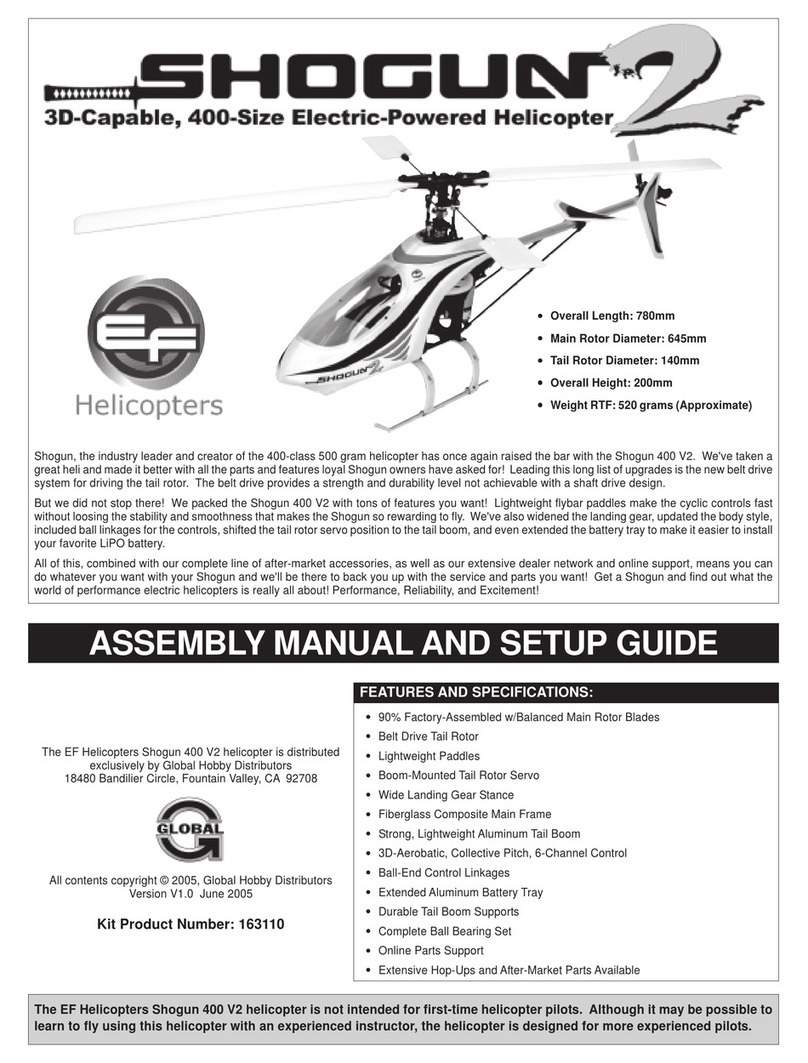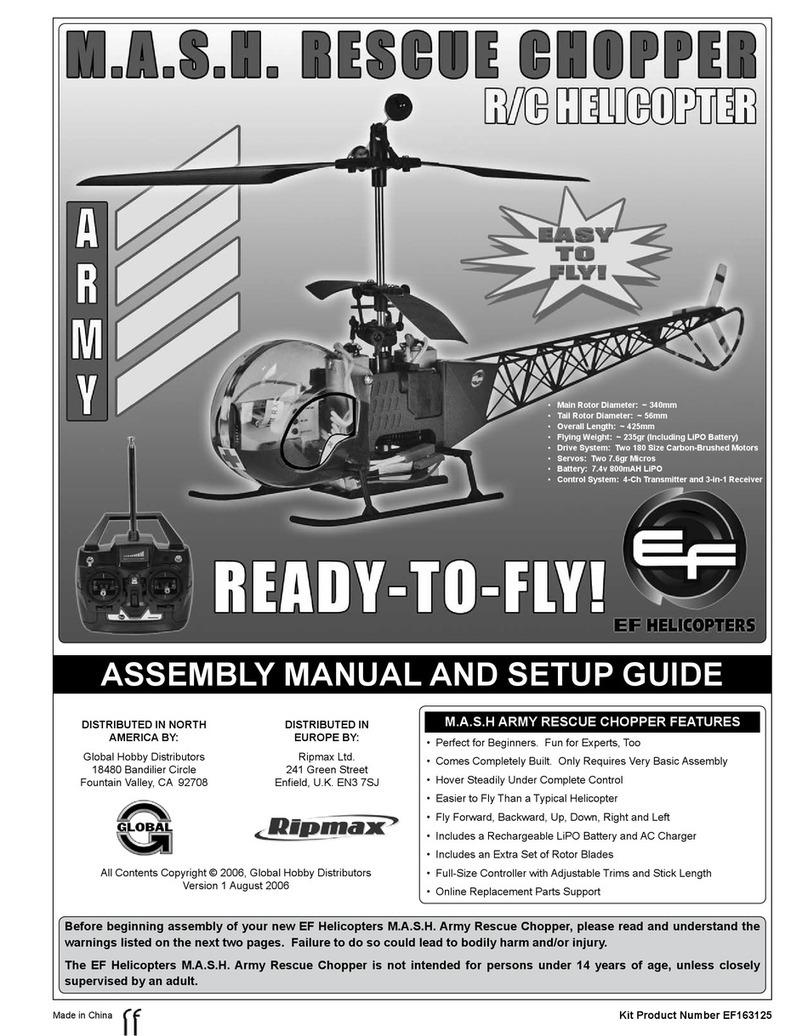EF Helicopter Mini-Stinger EF008 User manual

1

2
TABLE OF CONTENTS
Thank you for purchasing the EF Helicopter’s Mini-Stinger EP 2.4GHz RTF Helicopter.
The Mini-Stinger is a high-quality 2.4GHz electric-powered co-axial helicopter that's perfect for the
beginner to learn to y, or for the more experienced pilot to simply have fun. The Mini-Stinger is
designed specically to y indoors, either in your house or other indoor area. The helicopter is
powered by two electric motors which drive a co-axial rotor head which results in a very stable ying
model that makes learning to y much easier. In addition, an innovative 2.4GHz digital transmitter
with LCD and integral Li-Po charger for the helicopter's onboard battery is included.
Before ying your new helicopter, please carefully read through this Instruction Manual in its entirety.
Doing so will ensure your success the rst time around. As you can see, there's not much to it!
l Read the Safety Warnings and Important Information on Pages 3 through 5
l Identify the Parts and Familiarise Yourself with Your New Helicopter
l Charge the Li-Po Battery
l Test Your Helicopter and Make Final Pre-Flight Checks
l Become Familiar with How Your Helicopter Flies
l Choose Your Flying Area and Fly!
INTRODUCTION
WARRANTY TERMS
In North America
Your EF Helicopters Mini-Stinger EP 2.4GHz RTF Helicopter is warranted against manufacturer
defects in materials and workmanship, at the date of purchase.
In the United Kingdom/Europe
Your EF Helicopters Mini-Stinger EP 2.4GHz RTF Helicopter is warranted against manufacturer defects
in materials and workmanship for a period of 1 (one) year from the date of purchase. Warranty
service will be provided within one (1) year of the date of purchase only if you are able to provide
the original or a copy of the original dated sales receipt. This does not affect your statutory rights.
EF Helicopters guarantees this kit to be free from defects in both material and workmanship, at the
date of purchase. This does not cover any component parts damaged by use, misuse or modication.
In no case shall EF Helicopter's liability exceed the original cost of the purchased kit.
In that EF Helicopters has no control over the nal assembly or material used for nal assembly,
no liability shall be assumed for any damage resulting from the use by the user of the nal
user-assembled product. By the act of using the nal user-assembled product, the user accepts
all resulting liability.
Introduction ................................................ 2
Warranty Terms........................................... 2
Customer Service Information ...................... 3
Safety Warnings and Important Information .. 3
Kit Contents and Parts Identication ............. 5
Becoming Familiar with Your Helicopter ......... 6
Preparing to Fly Your Helicopter ................... 9
Flying Your Helicopter .................................11
Troubleshooting Guide ................................16
Exploded View Assembly Drawing ................17
Replacement Parts List ...............................18
Warranty Service Information ......................19

3
Global Hobby Distributors will not disclose the information it collects to outside parties.
We do not sell, trade, or rent your personal information to others. Your privacy is important to us.
Check out our support website at http://globalservices.globalhobby.com. There you will nd public message boards frequented
by other modelers and our technical support staff. This is a great place to get quick answers and advice on your new product.
To enable us to better serve your needs, please include your Email address with any correspondence you send to us. Your Email
address will be added to our Customer Service Database so you will automatically receive free updates and tech notices for your
particular product. You will also receive repair status updates (if applicable) and other important information about your product
as it becomes available.
IMPORTANT INFORMATION ABOUT YOUR EMAIL ADDRESS
CUSTOMER SERVICE INFORMATION
SAFETY WARNINGS AND IMPORTANT INFORMATION
l This model is not a toy, and it should not be treated as such. Children under 14 years of age
should not use this product unless closely supervised by an adult.
l This model is powered using a 1 cell Lithium Polymer (Li-Po) battery. In addition to these General
Warnings, please read and understand the Li-Po battery warnings on page 4.
l Fly only indoors or in an area outside that is free of ANY wind at ALL times. Attempting to y
your model in any type of wind will make your model difcult or impossible to control.
l Even though this model is powered by electric motors it doesn't mean that you shouldn't exercise
caution when ying and operating it. You must use caution during use.
l Always be conscious of the spinning rotor blades. Be careful not to allow loose clothing to be
drawn into the spinning rotor blades.
l Because this model is operated by radio control, it is important to make sure you are always
using fresh and/or fully charged batteries. Never allow the batteries to run low or you could lose
control of the model.
l Do not allow any of the electrical components to get wet or electrical damage may occur.
l You should complete a successful check of the radio control system prior to each new day of
ying, or prior to the rst ight of a new or repaired model.
l If your model gets dirty, do not use any solvents to clean it. Solvents may damage the plastic.
l We strongly suggest that when you rst begin ying your model that you perform only basic
manoeuvres, such as hovering, until you are more familiar with the setup and ight characteristics
of the model. This will give you time to feel comfortable with the way the model reacts to control
inputs and power.
l Never y your helicopter in the street or at night. Always y in an area free of obstructions.
l When ying, make sure any spectators are behind you.
l Do not use your model to chase or harass pets or other animals.
n
General Warnings
For customer service questions or comments, please contact your local distributor. For information
about returning your product for warranty consideration, please see page 19.
In Europe
Ripmax Ltd.
241 Green Street
Eneld, EN3 7SJ, U.K.
Phone: (0) 20 8282-7500
Fax: (0) 20 8282-7501
Website: http://www.ripmax.com
In North America
Global Services
18480 Bandilier Circle
Fountain Valley, CA 92708
Phone: (714) 963-0329
Fax: (714) 964-6236
Email: service@globalhobby.net

4
SAFETY WARNINGS AND IMPORTANT INFORMATION
Lithium Polymer (Li-Po) batteries are signicantly more volatile than alkaline or NiCd/NiMH
batteries used in RC applications. All instructions and warnings must be followed closely.
Mishandling of Li-Po batteries can result in re.
n
Lithium Polymer (Li-Po) Battery Warnings
l Instructions about charging the Li-Po battery can be found on pages 9 and 10.
l DO NOT attempt to charge the Li-Po battery with any charger other than the integrated charger
in the transmitter that is included with your model or the optional AC or Mains charger for your
region listed on page 18.
l DO NOT leave the Li-Po battery unattended during the charging process.
l ALWAYS remove the Li-Po battery from the transmitter charger when not in use.
l ALWAYS charge the Li-Po battery on a re-resistant surface and never charge the Li-Po battery
near any ammable material.
l DO NOT use or charge the Li-Po battery if it's hot to the touch.
l DO NOT leave the Li-Po battery in direct sunlight or in a hot car or storage area, or get the Li-Po
battery wet or expose it to moisture.
l DO NOT short-circuit the Li-Po battery.
l DO NOT leave the Li-Po battery plugged into the model when not in use. The Li-Po battery should
be stored in a re-proof container.
l ALWAYS let the Li-Po battery cool between uses and charging.
l INSPECT the Li-Po battery before each use for swelling or other malformation. If the Li-Po battery
is damaged, it should be discarded. For more information, see page 5.
l DO NOT poke, bend or damage the Li-Po battery. The Li-Po battery's outer casing is soft and can
be damaged.
l DO NOT allow the Li-Po battery to ever exceed 160ºF (71ºC) for any reason.
n
FCC Information
This equipment has been tested and found to comply with the limits for a Class B digital device,
pursuant to Part 15 of the FCC Rules. These limits are designed to provide reasonable protection
against harmful interference in a residential installation. This equipment generates, uses, and can
radiate radio frequency energy and, if not installed and used in accordance with the operating
instructions, may cause harmful interference to radio communications. However, there is no
guarantee that interference will not occur in a particular installation.
If this equipment does cause harmful interference to radio or television reception, which can be
determined by turning the equipment off and on, the user is encouraged to try to correct the
interference by one or more of the following measures:
l Reorient or relocate the receiving antenna. Increase the separation between the equipment and
the receiver. Connect the equipment into an outlet on a circuit different from that to which the
receiver is connected. Consult the dealer or an experienced technician for help.
This device complies with Part 15 of the FCC Rules and with RSS-210 of Industry Canada.
Operation is subject to the following two conditions:
1) This device may not cause harmful interference, and....
2) This device must accept any interference received, including interference that may cause
undesired operation.

5
n
Lithium Polymer (Li-Po) and 'AA' Alkaline Battery Instructions for Disposal
This product must not be disposed of with other household waste. Instead, it is the user's
responsibility to dispose of this product by handing it over to a designated collection point
for the recycling of waste electrical and electronic equipment. The separate collection and
recycling of this product at the time of disposal will help to conserve natural resources and
ensure that it is recycled in a manner that protects human health and the environment.
For more information about where you can drop off this product for recycling, please
contact your local city or municipal ofce, your household waste disposal service, or where you
purchased the product.
KIT CONTENTS AND PARTS IDENTIFICATION
Remove the parts from the box and use the photo below to verify that your set contains all of the
correct parts.
SAFETY WARNINGS AND IMPORTANT INFORMATION
1
5
4
3
2
1) 2.4GHz Digital Transmitter
2) Four 'AA' Alkaline Batteries for Transmitter
3) 1 Cell 110mAh Li-Po Battery for Helicopter
4) Small Philips Head Screwdriver
5) Mini-Stinger 2.4GHz EP RTF Helicopter
This set contains all of the parts and accessories necessary for ight. There is nothing else to purchase!
When the transmitter batteries are depleted, replace with four 1.5 volt 'AA' Alkaline batteries.
Do not dispose of the depleted 'AA' Alkaline batteries in household waste, but take them to
an approved recycling centre for disposal (see Safety Warnings and Important Informaton above).
If your set is missing a part, or if a part appears damaged, please contact
your local distributor using the Customer Service Information on page 3.
Rechargeable NiCd or NiMH batteries (purchased separately) can be used to power the transmitter.
However, they must be charged separately outside of the transmitter with a compatible charger
(available separately). The transmitter does not provide for onboard charging of the 'AA' batteries.
Table of contents
Other EF Helicopter Toy manuals
Popular Toy manuals by other brands

FUTABA
FUTABA GY470 instruction manual

LEGO
LEGO 41116 manual

Fisher-Price
Fisher-Price ColorMe Flowerz Bouquet Maker P9692 instruction sheet

Little Tikes
Little Tikes LITTLE HANDIWORKER 0920 Assembly instructions

Eduard
Eduard EF-2000 Two-seater exterior Assembly instructions

USA Trains
USA Trains EXTENDED VISION CABOOSE instructions













